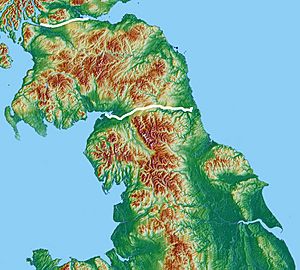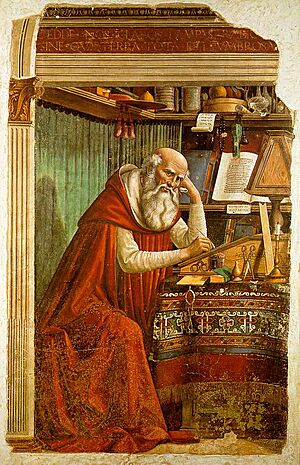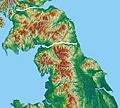Attacotti facts for kids
The Attacotti were a group of people in ancient times. Their names were written in Latin in different ways, like Atticoti or Atecotti.
They are first mentioned for raiding Roman Britain between the years 364 and 368 AD. They raided alongside other groups like the Scoti, Picts, and Saxons. Even some Roman soldiers who had left the army and local Britons joined in the raids. A Roman general named Theodosius defeated these raiders in 368 AD.
We don't know exactly where the Attacotti came from or how much land they controlled. Around the year 400 AD, Roman army units were formed using soldiers recruited from the Attacotti. We know this from an old Roman document called the Notitia Dignitatum. We also found a tombstone of a soldier who was identified as an Attacotti.
Contents
Roman Britain's Troubles (364–369 AD)
A historian named Ammianus wrote about the problems in Britain between 364 and 369 AD. He said that the Roman government there was not working well. Some local British troops, called the Areani, were even helping the raiders. Roman soldiers were leaving their posts and becoming bandits.
This situation happened after a failed attempt to take over the Roman Empire. A general named Magnentius tried to become emperor. After he failed, a harsh official named Paulus Catena punished many people in Britain. He was trying to find anyone who might have supported Magnentius. These events, plus problems caused by a Roman official named Valentinus, made things worse.
Ammianus described the raiders as groups moving around to find things to steal. During this time, one Roman commander was killed in a battle. Another was captured and killed in a surprise attack. (You can read more about this in the Great Conspiracy article.)
Because the Roman army in Britain was not strong enough, a large force was sent from Gaul. This force was led by Count Theodosius. He quickly brought back order and then worked to fix the political problems in the province.
Attacotti in the Roman Army
The Notitia Dignitatum is an important list from the early 5th century Roman Empire. It lists all the government offices and where they were located. It also names the staff, including military units.
Some of the names of Roman army units, called auxilia palatina, sound like "Attacotti." In 1876, a historian named Otto Seeck suggested that these units were related to the Attacotti. He found different spellings in the Notitia Dignitatum that he believed referred to the Attacotti.
Based on his research, he thought there were four possible units related to the Attacotti:
- Atecotti
- Atecotti juniores Gallicani
- Atecotti Honoriani seniores
- Atecotti Honoriani juniores
Later, a tombstone was found in Thessalonica, a city in the Roman area of Illyricum. It was for a soldier from a unit called "Atecutti." This discovery helped support the idea that Attacotti units were part of the Roman army. The Notitia Dignitatum also mentions an Atecotti unit in that same Roman area.
Were the Attacotti from Ireland?

For a long time, some Irish scholars thought the Attacotti might have come from Ireland. This idea started as early as the 17th century and continued into the 18th and 19th centuries. Scholars like Charles O'Conor and John O'Donovan noticed that the Latin name Attacotti sounded similar to an Old Irish term, aithechthúatha.
Aithechthúatha was a general name for certain groups of people in Ireland. It usually meant "rent-paying tribes" or "tributary peoples." Since Irish groups were known to raid the western coast of Britain during the late Roman period, some thought the Attacotti might be one of these groups.
Charles O'Conor helped make this idea popular in the late 1700s. However, many scholars disagreed with this connection into the late 1800s.
More recent studies have questioned the link between Attacotti and aithechthúatha based on how words change over time (etymology). Early scholars based their ideas on Old Irish from medieval writings. But the language spoken in the 4th century, when the Attacotti were in Britain, was different. This earlier form is called Primitive Irish.
Our understanding of the Irish language changed a lot in the late 1800s, thanks to scholars like Rudolf Thurneysen. He believed that Attacotti and aithechthúatha are not connected. He thought the Primitive Irish word for aithechthúatha would have sounded very different from Attacotti.
Even though some Irish groups who raided Britain might have been called aithechthúatha, it's still hard to say for sure if they were the Attacotti. There are still questions about the timing and exact identification.
Images for kids








